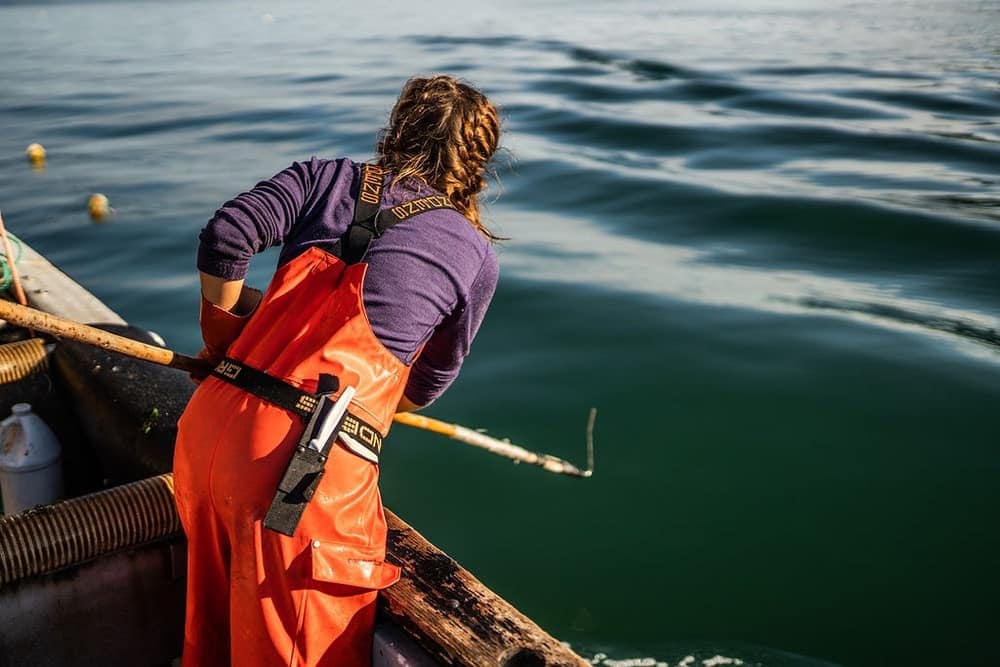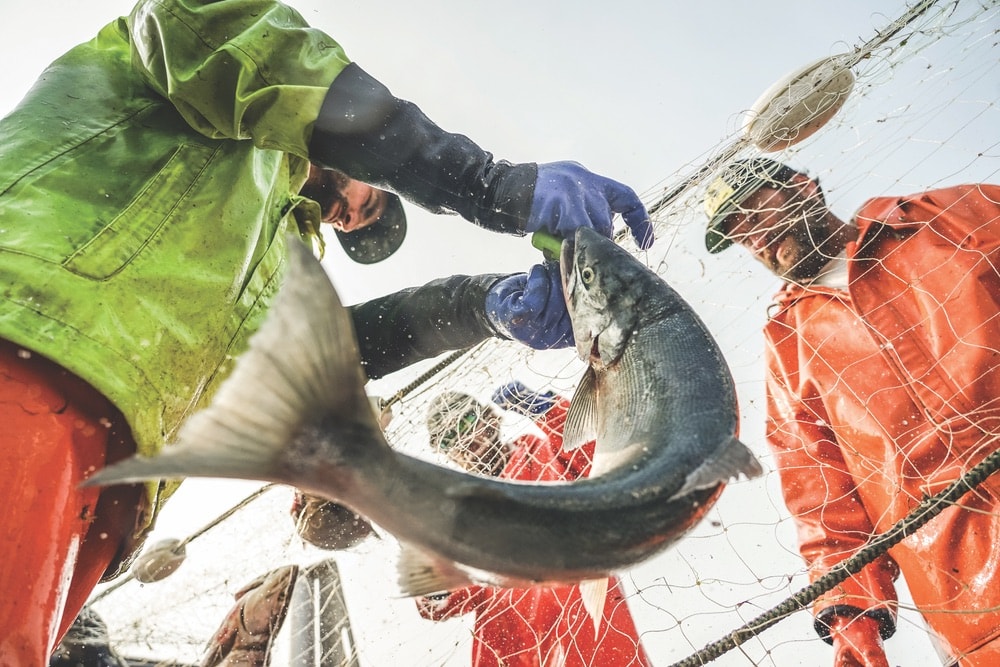
vie-magazine-commercial-fishing-life-hero
Commercial fishing is one of America’s last “hunter-gatherer” industries and can be a harrowing profession for the men and women who spend months on boats in remote parts of Alaska, such as Bristol Bay, pictured here.
The Last Hunter-Gatherers
Fishing the Final Frontier
By Megan Waldrep | Photography by Bri Dwyer
In northwestern Washington, Serena Dabney, Bri Dwyer, and I sit around the dining room table near a large window looking over the Salish Sea. Serena’s four-month-old baby boy, Waylon, is bobbing gently in his bouncy chair, cooing and smiling as his mom reflects on a decade of commercial fishing in Bristol Bay, Alaska, and her transition to starting a family. She explains that Bristol Bay, specifically, is an “uprooting fishery,” where fishermen need to drop everything for months in the summer before returning home to resume a normal life. (A fishery is defined as a place where fish are caught for commercial purposes.)
There’s no room for early motherhood in Bristol Bay. If you’re picking fish from a gill net, pregnancy and breastfeeding are impracticable, not to mention dangerous. If Serena wanted a family, giving up a life she knew was the only choice. “Initially, it was really hard,” she says. “It felt like a huge part of my identity was being given up for something I didn’t immediately have to replace it.” Three years after her last season, Waylon was born, as was her new identity as a mother. Though Serena no longer fishes, her husband, Dave Jennings, has been a commercial fisherman for twenty-two years and continues to fish the bay for sockeye salmon. “Knowing that commercial fishing is still part of our family is really important to me,” Serena says. “Coming from a commercial fishing family—my dad fished, and now I’m with someone who fishes—I don’t feel that I’ve totally lost it because it’s still part of our family identity even though it’s not part of mine.”
- According to the Alaska Department of Fish and Game, the Bristol Bay fishery accounted for over $306 million worth of salmon in 2019, topping its all-time record.
- Dungeness crab from Puget Sound
- Savannah Lishnerness and Sean Dwyer reel in a crab trap from Puget Sound.
Serena’s older brother, Chris Dabney, is also a commercial fisherman in Alaska and recently took over their father’s spiny lobster permit to fish in Santa Barbara, California. That’s how we’re all linked; Chris is my fiancé, and Bri Dwyer is a professional photographer who shot pictures aboard Dave’s boat a few years ago when Chris was a deckhand. Bri captures the lifestyle more vividly than any photographer in the game, and after I saw her images and we became pen pals for a few months, Bri traveled to California to shoot the lobster fishery. We became fast friends. Married to Captain Sean Dwyer, a former cast member on Discovery Channel’s Deadliest Catch, Bri says shooting the industry is a way to understand her husband’s career more intimately. “I am drawn to the work ethic and the physicality of the industry and what both of those bring to my images,” Bri says. “It’s real sweat, real sacrifice, and real people working hard. Every image I create on the water is exactly what’s happening in real life.”
Only the strong survive commercial fishing in Bristol Bay. Long hours, lack of sleep, no showers, and no contact with family for weeks are taxing both mentally and physically. And that says nothing of the forty-knot winds, the cold weather, and the confused seas that make commercial fishing one of the most dangerous jobs in existence. So, really, only the strong survive if they’re vigilant and lucky. It’s a saltwater-in-the-veins love for the sea and the potential to make a year’s salary in a few short weeks that call fishermen to a job that many wouldn’t dare take. The industry is so huge, it produces billions of dollars’ worth of seafood every year, yet people within the industry are connected less intricately.
- Mandy Hansen has been featured on the hit Discovery Channel series Deadliest Catch.
For partners of commercial fishermen, it can be a solitary life. For months on end, a partner must handle all household responsibilities, care for children and pets, and keep spirits high until their loved one returns home. Other women who can relate are few and far between, which is why the private Facebook group Partners of Commercial Fishermen acts as a support community for women to express worry and stress to like-minded people.
This group is also helpful when, for example, you discover your fiancé is going to hire a female deckhand for spiny lobster season. A deckhand who will sleep in the same cabin as him a few nights a week. A woman who will spend more time with your man than you will for six whole months. That was a personal struggle I dealt with last year. Trying to remain calm when I first heard the news, I asked Chris why he decided to hire a woman. “I hired Emily because she had a lot of previous fishing experience, which is a huge plus,” he said. “She had fished in Alaska, which is definitely one of the more demanding fisheries out there, and she came highly recommended by a buddy of mine who said that she was tough and reliable.” Chris explained that hiring deckhands is a game of chance. You can’t know from a simple interview how they will perform or if your personalities will mesh in a difficult work environment. “Emily seemed eager,” Chris said. “How quickly they want to start and how much they want to work is a good indication that they are hardworking and there to make some money.”
“It’s real sweat, real sacrifice, and real people working hard. Every image I create on the water is exactly what’s happening in real life.”
Trusting our relationship, I quickly realized how hard it could be for a woman in a male-dominated profession. I wanted not only to ease the added stress of her situation, but also to be a friend.
Deckhand Emily Ekbom is a thirty-year-old from Michigan who discovered commercial fishing after moving to San Francisco. Once there, the small-town Midwestern girl at heart found she wanted more than partying at big-city bars. “A friend of mine randomly called and said he was heading back up to Alaska to work on a boat, and I knew that’s what I wanted to do,” Emily says. She subleased her apartment, sold her car, quit her job, and moved everything into storage. “I found a female captain on Craigslist, of all places, looking for female crew members to help her catch salmon on her seiner in Kodiak, Alaska.” Since then, Emily has worked four fisheries along the West Coast and says she hasn’t had problems with men being inappropriate. “More so, it’s problems with guys being able to comprehend they’re on an even working field with a chick.” Though money is not guaranteed—fishermen do not know how much they’ll be paid until the boat is docked at the end of the season—and the weather can be gnarly, to say the least, Emily looks to the simple pleasures like living on a boat for months at a time, watching orcas cruise by, and feeling the freedom that no cell-phone service brings. A slower life. “I love being able to unplug and just live in every moment, good and bad,” she says. “We overcomplicate our lives with so many unnecessary things and distractions.”
- Captain Dave Jennings (right) and his crew untangle salmon from their nets in Bristol Bay, Alaska.
- Fisherman Rosario Aiello working hard in Bristol Bay
- Chris Dabney and Megan Waldrep
- Lobster caught off the coast of Santa Barbara, California
That’s how Dave sees it too. Once an Army Ranger, he explains that the challenge of harsh conditions is part of who he is. “It’s a lot of why I was drawn to Buddhism in high school. This whole life is transient, and the suffering is how we take it in our mind,” Dave says. “If you try and perceive it a little differently, it’s not that bad. There’s beauty out there.” He admits he’s more drawn to boatbuilding than commercial fishing, but he’ll fish as long as it stays profitable. “I’d love to continue for twenty years and have Waylon take over, but I also don’t care if he does,” Dave admits. “I’d also love to spend the next twenty years boatbuilding in the winter and sailing with him all summer.”
Back in Washington, baby Waylon has fallen asleep. Serena, Bri, and I clear the table and quietly say good-bye to each other before Chris and Dave return home for dinner. With both parents, an uncle, and a grandfather—not to mention great-uncles and second cousins—who have been or are currently in the industry, Waylon could be a third-generation fisherman to enter the grind. No matter where his life may lead, Waylon embodies thousands of families who make up the American commercial fishing industry, a mighty group of men and women who are some of the last hunter-gatherers in America’s last frontier. Together, they are the faces behind US wild-caught seafood. These are the faces behind each catch.
— V —
Visit BriDwyerImages.com to see more photos from commercial fishing life in America.
Megan Waldrep is a freelance writer who recently traded life on a thirty-four-foot sailboat in Mexico for a vintage Airstream in Carpinteria, California. She also writes a relationship blog called I Heart under the pen name Elizabeth Rose. What does all this mean? Find out at MeganWaldrep.com.
Share This Story!
KEEP UP WITH THE LATEST STORIES FROM VIE





































































































































































